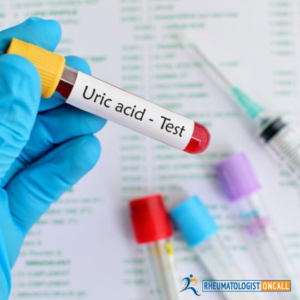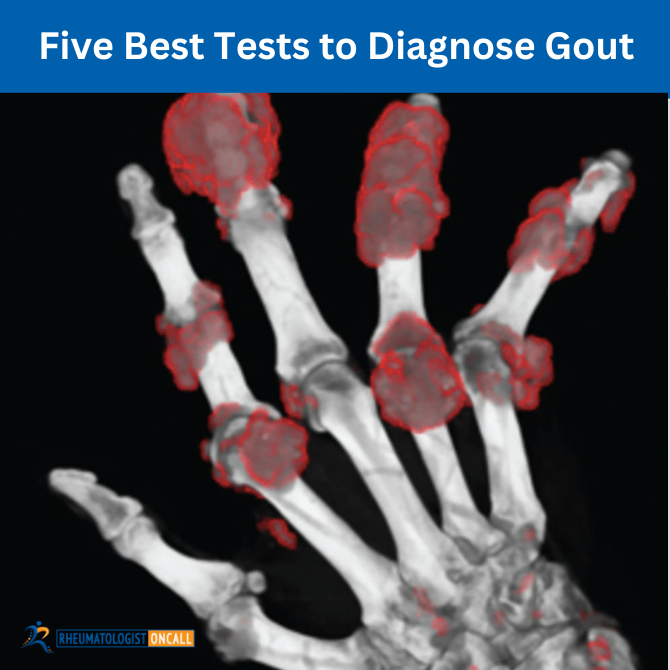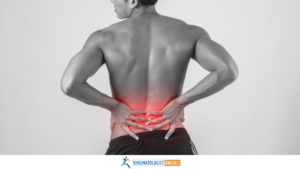SHARE
Ever wondered, “Do I have gout?” The journey to a gout diagnosis can feel like a long winding road. So let’s unravel this mystery together. This blog post will walk you through the five crucial tests we use to diagnose gout, making the process easier to understand.
Unmasking the Gout Culprit: How Do We Confirm It?
Suspecting you have gout is one thing, but how can we be sure? There are signs and symptoms that you should pay attention to. In my previous blogs, I have described the most common signs of gout, from pain to swelling and severe limitation in moving your joints. There is genetics involved. If your parents had gout, there is a high chance that you might develop gout.
Here’s where the detective work begins:
1. Gout Blood Tests: The First Clue
Blood tests are our first clue in the gout investigation. They measure your uric acid levels, which can be unusually high when gout is the culprit. However, if the uric acid is tested during a gout attack, the numbers might not be high, and that can create more confusion for you and your doctor. So you might need to test the uric acid a few other times to see the real value.
At the same time, I often check how kidneys and liver are doing. If the kidney function is poor, that might cause your uric acid to be high as it is not eliminated from your body.
Plus, I look at hemoglobin A1c since gout often hangs around with diabetes.

2. Synovial Fluid Analysis: Catching the Gout in Action
Synovial fluid analysis is my secret weapon in nailing the gout diagnosis. If I can, and the patient is willing to accept that, I might take a tiny sample of fluid from the troublesome joint and put it under a microscope. If I find needle-shaped uric acid crystals with a distinctive negative double refraction, I know gout is the culprit, and I confirm the diagnosis immediately. However, some patients are hesitant to put the needle in their joints as they suffer from a tremendous amount of pain. But if the joint is swollen and there is much pain, taking fluid from a joint is the best and preferred method to diagnose gout.
3. Imaging: Plain Xrays
We sometimes need a visual on the problem, and that’s where imaging comes in. X-rays are often used in the process of diagnosing gout, primarily to rule out other possible conditions since early gout usually doesn’t show any distinctive features on X-rays. However, as the disease progresses, some characteristic findings may be observed:
No changes in the early stages: In the initial phases of gout, the X-ray might not show any significant changes. This can sometimes make early diagnosis challenging based only on X-rays.
Soft tissue swelling: An acute gout attack might show up on an X-ray as swelling around the joint, although this can be caused by many other conditions too.
Urate crystals deposits (tophi): As gout progresses, urate crystals may accumulate in joints and soft tissues, forming nodular masses known as tophi. Tophi often appear as well-defined, ‘punched-out’ erosions with sclerotic (hardened) margins on X-rays. They are typically located around the joint and may sometimes be seen within the joint space.
Bone erosion: Over time, the buildup of uric acid crystals can cause damage to the bone around the joint, leading to bone erosion that can be seen on X-rays. Cysts or holes in the bone may also be visible.
It’s important to remember that while X-rays can provide valuable information and help diagnose gout, they are typically used alongside other diagnostic tests and methods, such as blood tests and joint fluid analysis. An X-ray alone may not provide a definitive diagnosis of gout.
4. Ultrasound
Ultrasound is an increasingly utilized tool for the diagnosis and monitoring of gout. Here are some characteristic changes that can be seen in gout through ultrasound imaging:
Double Contour Sign: This is one of the most specific ultrasound findings in gout. The double contour sign appears as an abnormal bright band on the surface of the cartilage, which is due to urate crystal deposition. This is a powerful indicator of gout.
Tophi: Tophi can appear as nodules with a heterogeneous appearance. They can be located within the joint space or in the soft tissues around it.
Erosions: Chronic gout can lead to bone erosions due to the destructive nature of the urate crystals. These erosions can be seen on ultrasound as discontinuities of the bone surface.
Effusion and Synovitis: Gout can cause joint inflammation (synovitis) and excess fluid in the joint (effusion).
5. CT Dual Energy: The Game-Changer in Gout Diagnosis
As the healthcare world evolves, we’re staying ahead of the curve. In the case of gout, one of the most exciting developments is the use of CT Dual Energy imaging. But what exactly is it, and how does it help us diagnose gout?
CT Dual Energy is an advanced imaging technique. It uses two different X-ray beams to capture super-detailed images of your body. This is especially helpful for us in diagnosing gout because it can visualize uric acid deposits in the joints that might not always show up in standard imaging tests. So, how does this work? When the CT scan is performed, the two X-ray beams pass through the body. Different tissues, including uric acid crystals, absorb these X-rays differently. This allows the software to differentiate between various tissue types. For gout, it means we can see exactly where those pesky uric acid deposits are in your joints.
CT Dual Energy isn’t just cool technology; it’s a powerful tool for diagnosing gout:
Accuracy: It gives us a precise picture of uric acid deposits, even when they’re not visible, with regular imaging techniques.
Non-invasive: It doesn’t require incisions or injections, making it a more comfortable and patient-friendly process.
Speed: It’s fast and efficient, aiding in quicker diagnosis and treatment planning.
Guidance for Treatment: By showing us the extent of uric acid crystal buildup, it can guide treatment decisions and help evaluate how well your current gout management strategy is working.
While CT Dual Energy is a game-changer, remember it’s one tool in our toolbox.
What’s Next? Manage Your Gout
Beyond diagnosis, managing gout involves lifestyle and dietary changes and treatment for preventing gout attacks and also lower your uric acid level. Here, at Rheumatologist OnCall, I often diagnose and treat patients with gout either during a gout attack or patients with chronic gout.
Remember, you don’t have to face gout alone. We’re always here, ready to help when you need us most. Your journey to a pain-free life begins now. Take the first step, and let us be your partner in overcoming gout. Contact Rheumatologist OnCall today!














